Powerful Tool for Protein-Protein Interaction Analysis
The yeast Saccharomyces cerevisiae (S. cerevisiae) is a recognized simple eukaryote model system which genome can be easily manipulated. The S. cerevisiae VN-Fusion Library was created by Dr. Won-Ki Huh of Seoul National University (Korea).
The VN-Fusion Library consists of 5,809 VN-tagged Open Reading Frames (ORFs) covering 93% of the yeast proteome.
Bimolecular Fluorescence Complementation (BiFC) assay
Most biological processes are carried out and regulated by dynamic networks of protein-protein interactions. The Bimolecular Fluorescence Complementation (BiFC) assay is now regarded as one of the most advanced and powerful tools for studying in vivo detection of protein–protein interactions in several orgarnisms. The BiFC assay is based on the formation of a fluorescent complex by fragments of yellow fluorescent protein, brought together by association of two interacting partners fused to the fragments. This approach enables visualization of the subcellular localizations of specific protein complexes in the normal intracellular environment.
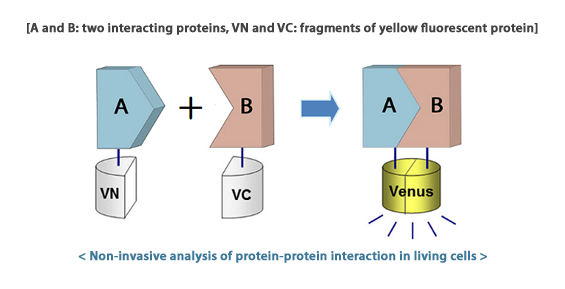
Features and Benefits
 A powerful tool for studying protein-protein interactions in living cells
A powerful tool for studying protein-protein interactions in living cells
- Non-invasive method for analyzing fluorescence without the need for any external cofactors
 Clear visualization of subcellular protein-protein interaction localization
Clear visualization of subcellular protein-protein interaction localization
- Formation of a fluorescent complex
 Stronger signal and direct readout measurable with relatively simple equipment
Stronger signal and direct readout measurable with relatively simple equipment
- Using a fluorescence microscope
 Genome-wide high-throughput screening possible
Genome-wide high-throughput screening possible
- 93% yeast proteome coverage
 Unknown protein function analysis through functional complementation is possible
Unknown protein function analysis through functional complementation is possible
 Analysis of proteinylation (ubiquitination, sumoylation, neddylation) is possible
Analysis of proteinylation (ubiquitination, sumoylation, neddylation) is possible
Specifications
|
S. cerevisiae VN-Fusion Library |
|
Strains |
5,809 strains |
|
Selection Marker |
KIURA3 |
|
Genotype |
All S. cerevisiae VN-Fusion strains were derived from BY4741
(MATa his3Δ1 leu2Δ0 met15Δ0 ura3Δ0)
Haploid |
|
Culture media |
YPD: for general culture and maintenance medium
SC-Ura or SC-His: for medium selection & counter selection (auxotrophic culture) |
|
Strain verification |
Medium selection & Counter selection
Check PCR |
|
Storage |
Store at -70°C (Glycerol type)
Store at 22°C to 25°C (Agar type) |
|
References |
in vivo quantification of protein-protein interactions in Saccharomyces cerevisiae using bimolecular fluorescence complementation assay
Min-Kyung Sung, Won-Ki Huh J Microbiol Methods. 2010. 83(2), 194-201.
• More information
Bimolecular fluorescence complementation analysis system for in vivo detection of protein-protein interaction in Saccharomyces cerevisiae
Min-Kyung Sung, Won-Ki Huh Yeast. 2007. 24(9), 767-775.
• More information
Construction, verification and experimental use of two epitope-tagged collections of budding yeast strains
Russell Howson, Won-Ki Huh, Sina Ghaemmaghami, James V. Falvo, Kiowa Bower, Archana Belle, Noah Dephoure, Dennis D. Wykoff, Jonathan S. Weissman and Erin K. O’Shea
Comp Funct Genom. 2005. 6, 2–16.
• More information
Global analysis of protein localization in budding yeast
Won-Ki Huh, James V. Falvo, Luke C. Gerke, Adam S. Carroll, Russell W. Howson, Jonathan S. Weissman and Erin K. O’Shea Nature. 2003. 425, 686-691.
• More information |
|
Patent |
10-2009-0048746 |
Construction
A ~2.5 kb DNA cassette including the VN and KlURA3 marker gene was amplified by PCR using pFA6a-VN-KlURA3 as a template, and "universal" F2CORE (5'-GGTCGACGGATCCCCGGGTT-3') and R1CORE (5'-TCGATGAATTCGAGCTCGTT-3') primers. The resulting DNA cassette was transformed into ~6,000 yeast strains from the TAP-tagged collection (Ghaemmaghami et al., 2003). The transformed cells were spread on SC-Ura plates and incubated at 30°C for 3 days. Among several colonies, 10 colonies were picked and streaked on fresh SC-Ura plates, and incubated at 30°C for 24 hours. To check correct switching to the VN tag, cells grown on SC-Ura plates were replica-plated onto SC-His plates. Cells growing on SC-His plates were discarded.
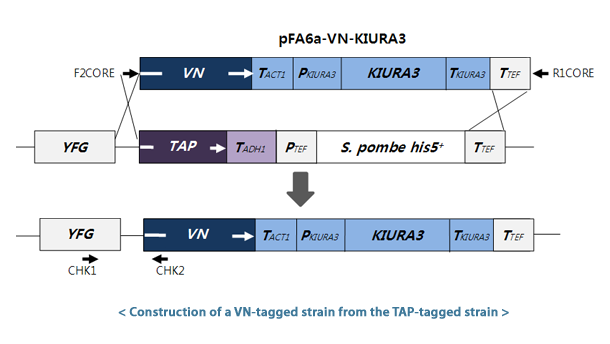
Validation
To confirm that the TAP tag was successfully switched to the VN tag, the colonies selected by SC-Ura medium were checked by colony PCR using the CHK1 [gene-specific primer] and CHK2 [5'-CACCATGGTGGCGATGGATC-3'] primers. A small aliquot of freshly grown cells was resuspended in 5 μl water and boiled in a 96-well plate (99°C for 5 min in the thermal cycler). 5 μl boiled cells and 2.5 μl of 5 μM unique CHK1 primer were added to a PCR premix (AccuPower® HotStart PCR PreMix [Bioneer, K-5050, Korea], 0.25 μl 50 μM CHK2 primer) and PCR was performed [94°C 3 min, 35×(94°C 30 s, 50°C 30 s, 72°C 1 min), 72°C 10 min]. We analyzed the results of PCR by agarose gel electrophoresis, identifying correct integrants by the presence of a PCR product of appropriate size [~600 bp].
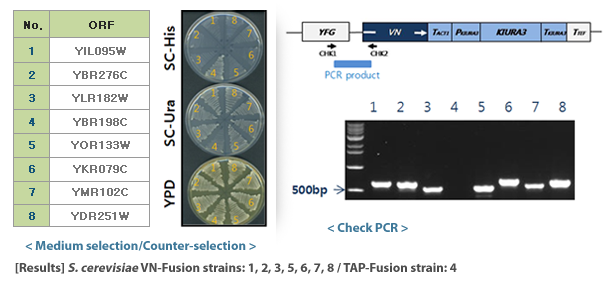
Application
Visualization of subcellular location of protein–protein interaction
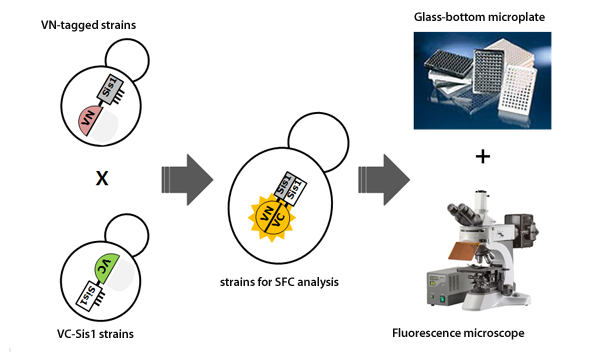
Example: Fluorescence images of diploid cells expressing the C-terminally VN-tagged Sis1 and the C-terminally VC-tagged Sis1 together.
Sis1 is a Type II HSP40 co-chaperone that interacts with the HSP70 protein Ssa1 (Luke et al., 1991), and has been shown to form a homodimer (Sha et al., 2000). The bimolecular fluorescence complementation (BiFC) signal was clearly detected in the nucleus and the cytoplasm, indicating that the VN-tagged Sis1 interacted with the VC-tagged Sis1 in the nucleus and the cytoplasm, where Sis1 is reported to be localized (Huh et al., 2003). The BiFC signal was not detected in the diploid cells expressing either the VN-tagged Sis1 or the VC-tagged Sis1 alone.
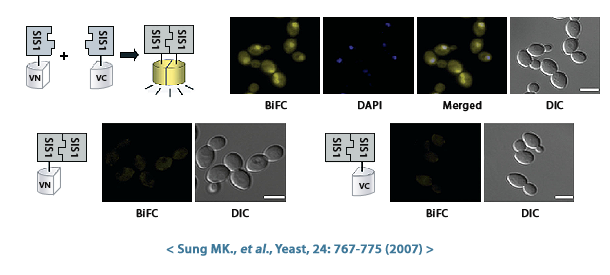
Manual
• S. cerevisiae VN-Fusion Library-Manual
MSDS
• S. cerevisiae VN-Fusion Library-MSDS
Brochure
• S. cerevisiae VN-Fusion Library - 2011 Brochure
Quality Assurance
Bioneer is the holder of Quality Management System Certificates for the following standards.
• ISO 9001:2008 - certificate
|
Cat.No.
|
Product Description
|
Price
|
Add to Cart
|
| V-1010VN-A
|
S. cerevisiae VN-Fusion Individual Strains, Agar type
|
Inquire
|
|
| V-1010VN-G
|
S. cerevisiae VN-Fusion Individual Strains, Glycerol type
|
Inquire
|
|
| V-1030VN
|
S. cerevisiae VN-Fusion Library Set, Glycerol type
: 5,809 strains, 63 plates (96-well)
|
Inquire
|
|
| V-1030VN-P
|
AccuOligo® S. cerevisiae VN-Fusion Library
Validation Primer Set : 63 plates (96-well)
|
Inquire
|
|